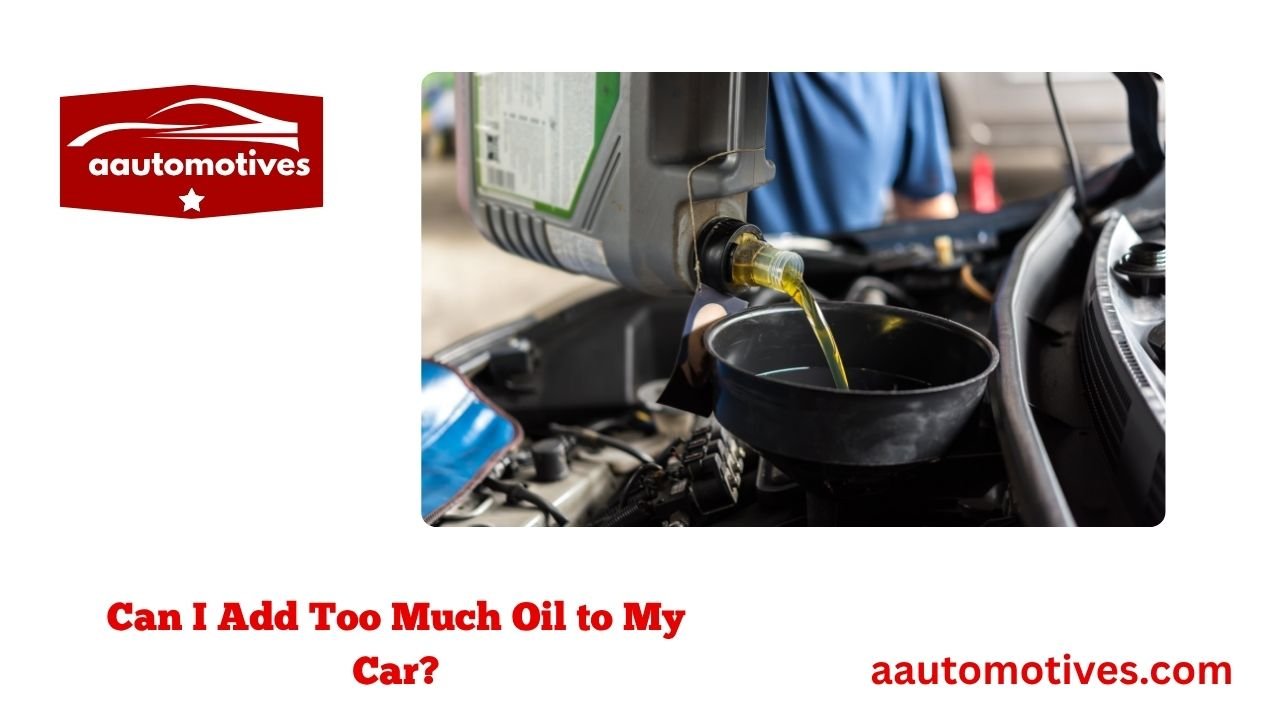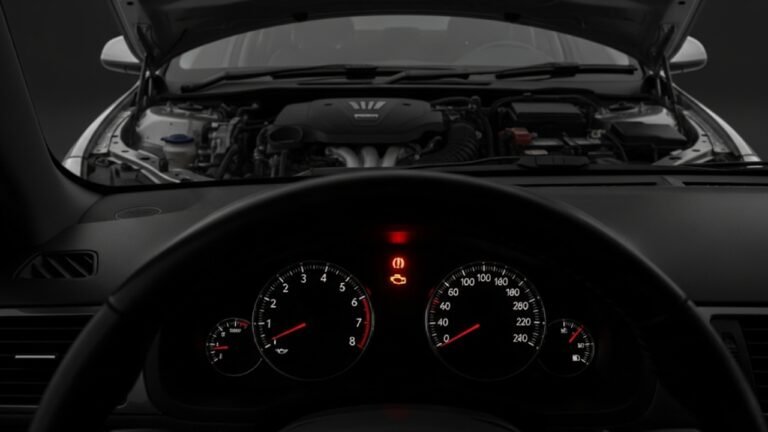Can I Add Too Much Oil to My Car?

It was a sunny Saturday morning. I had just finished washing my car, and I thought, “Let me just check the oil real quick.” The dipstick was a little low, so I poured some in. And then, a little more. Before I knew it, the level had gone well past the “max” line. Oops. That moment sparked a deeper question—can I add too much oil to my car, and if so, what’s the damage?
If you’re like me, you’ve probably wondered about this before. You want to take good care of your vehicle. You think you’re doing something helpful, but what if you’re actually making a big mistake?
Let’s break it all down together. This guide will walk you through everything—why too much oil is a problem, what symptoms to watch for, how to fix it, and most importantly, how to avoid it again.
In This Article
- 1 What Happens When You Add Too Much Oil to Your Car?
- 2 How Much Oil is Too Much? The Danger Zone
- 3 Symptoms of Overfilled Engine Oil
- 4 How to Check if You’ve Overfilled the Oil
- 5 What Should You Do If You Added Too Much Oil?
- 6 Why Your Car Needs the Right Amount of Oil
- 7 Quick Tips to Avoid Overfilling Your Engine
- 8 Is Driving with Too Much Oil Always Dangerous?
- 9 What Damage Can Too Much Oil Cause in the Long Run?
- 10 Real-Life Story: How a Simple Mistake Cost Me $1,200
- 11 Why Modern Engines Are Less Forgiving
- 12 Frequently Asked Questions
- 12.1 1. Can I drive short distances with too much oil in my car?
- 12.2 2. Will an oil overfill fix itself over time?
- 12.3 3. Can too much oil cause white smoke?
- 12.4 4. Is it better to have slightly more oil or slightly less?
- 12.5 5. How do I know the exact oil capacity of my engine?
- 12.6 6. What happens if I don’t fix an oil overfill?
- 12.7 7. Can a mechanic tell if I overfilled my oil?
- 12.8 8. How long can I drive with too much oil?
- 13 Final Thoughts: Oil Care is Self-Care (For Your Car)
What Happens When You Add Too Much Oil to Your Car?

Here’s the issue. Inside your engine, there’s something called a crankshaft. It spins very fast—like thousands of times a minute. When you overfill the oil, the crankshaft ends up whipping it like a blender. That creates foam. And foam isn’t a good lubricant.
What does that mean for your car? The oil pump struggles to circulate foam properly. So your engine parts, instead of being protected, start grinding against each other. This can cause overheating, pressure buildup, and even engine failure in worst-case scenarios. Scary, right?
Think of it like trying to walk through a room filled with bubble wrap instead of air. Sounds fun for a second, but then you realize—you can’t breathe properly.
How Much Oil is Too Much? The Danger Zone
Now let’s get real. How much extra oil is “too much”?
Car manuals usually recommend a level between the “min” and “max” markers on your dipstick. Adding a few millimeters over the max line isn’t ideal, but probably won’t blow up your engine. But if you’ve added half a quart or more over the limit, you’re entering dangerous territory.
Here’s a quick oil level guide:
| Oil Level | Risk Level | What to Do |
|---|---|---|
| Below MIN | High risk of engine wear | Add oil immediately |
| At MIN to MAX | Safe zone | No action needed |
| Slightly Above MAX | Medium risk | Monitor; consider draining |
| 0.5 quart+ above MAX | High risk of damage | Drain excess oil ASAP |
So yes, you can add too much oil to your car, and the side effects range from annoying to downright costly.
Symptoms of Overfilled Engine Oil
Okay, let’s say you’re not sure whether you went overboard. What should you look out for? Your car might be trying to tell you something. Here are the common signs that you’ve added too much oil:
-
Blue or white smoke from the tailpipe
-
Burning oil smell inside the car
-
Oil leaks forming under the car
-
Poor fuel economy
-
Sluggish engine performance
-
Warning lights like the check engine or oil pressure light
These aren’t just random issues. They all link back to what’s going on inside your engine. Too much oil can cause leaks around the seals, or burn up inside the combustion chamber, leading to all kinds of performance issues.
It’s kind of like overwatering a plant. A little bit helps it grow. Too much? You drown the roots and kill it slowly.
How to Check if You’ve Overfilled the Oil
So you’re standing in your driveway, second-guessing yourself. Been there! The good news is that checking your oil level is pretty simple. Here’s how you can do it right:
-
Let the engine cool down for at least 10 minutes after turning it off. Hot oil can give false readings.
-
Pull out the dipstick, wipe it clean, and reinsert it all the way.
-
Pull it out again and look at the level.
-
The oil should be between the min and max lines—if it’s over, that’s your red flag.
If the dipstick looks milky or bubbly, that’s another sign you may have gone overboard. The foaming means air has been mixed into the oil, and that’s not good for lubrication.
What Should You Do If You Added Too Much Oil?
Alright, you checked your dipstick and confirmed it. The oil is way over the top. Don’t panic—you’ve got a few good options to fix this.
1. Use an Oil Extractor (Easy Method)
This tool sucks out excess oil through the dipstick tube. It’s clean, quick, and you don’t have to get under the car.
2. Drain Oil from the Plug (Old-School Way)
If you’re handy, you can drain a small amount from the oil pan by unscrewing the drain plug. But be careful—it’s easy to take out too much.
3. Visit a Mechanic
If you’re unsure or the car is already acting weird, it’s best to let a pro handle it. Especially if you think internal damage might have started.
Important Tip: After draining some oil, always recheck the level with your dipstick. It’s easy to go from too much to too little.
I remember once draining the oil myself. Thought I was being slick. Ended up pulling out nearly all of it and driving with too little oil. Talk about a double mistake. Lesson learned.
Why Your Car Needs the Right Amount of Oil
You’ve probably heard the phrase, “oil is the lifeblood of the engine.” It’s true. But just like blood pressure, too much or too little is dangerous.
Oil does three main jobs:
-
Lubricates moving parts so they don’t grind
-
Cools down the engine by reducing friction
-
Cleans debris and particles through circulation
But when you overfill it, the balance goes off. Your oil turns into a foamy mess, can clog filters, and may over-pressurize the system, leading to leaks or gasket failure.
Imagine drinking 10 glasses of water before bed. Your body doesn’t thank you. It’s overwhelmed. That’s your engine on too much oil.
Quick Tips to Avoid Overfilling Your Engine
Let’s be honest—most overfills happen because we get a little too confident. Or impatient. I’ve done it more times than I care to admit. Here’s how to avoid it:
-
Read your owner’s manual to know the correct oil capacity.
-
Pour slowly and in small amounts.
-
Check your dipstick regularly while adding oil.
-
Use a funnel to avoid spills and control the flow.
And here’s a good rule of thumb: If the dipstick says you’re low, add only half a quart first, then check again. Most cars don’t need a full quart just to top off.
Is Driving with Too Much Oil Always Dangerous?
Let’s say you accidentally added a little too much oil, but your car still drives fine. Should you freak out?
Not necessarily.
If it’s just a tiny bit over, your engine might still cope. But if it’s noticeably above the safe zone, even if there aren’t symptoms yet, you’re playing with fire. It’s kind of like eating too much salt—you won’t feel it right away, but your body’s working harder than it should.
So while “can I add too much oil to my car” might sound like a minor question, the long-term impact can be major if ignored.
What Damage Can Too Much Oil Cause in the Long Run?
Adding too much oil once might not seem like a huge deal. But what if it becomes a habit? Over time, consistently overfilling your engine oil can lead to serious internal damage that’s both expensive and avoidable.
Here’s what might happen if the problem isn’t corrected:
-
Blown gaskets – Too much oil increases pressure, which can blow seals or gaskets, causing oil to leak or spray inside the engine.
-
Catalytic converter damage – Excess oil can burn inside the exhaust system, clogging or destroying the catalytic converter, a costly component to replace.
-
Spark plug fouling – Oil can coat the spark plugs, leading to misfires and poor fuel combustion.
-
Sludge build-up – Over time, oil foaming and burning can lead to carbon deposits and sludge inside your engine, slowing everything down.
Think of your engine like a tight-knit team. Each part depends on balance. When oil throws that balance off, it’s like one teammate trying to do too much—it ends up hurting everyone else.
Real-Life Story: How a Simple Mistake Cost Me $1,200
I once had a friend named Jake who owned a sweet 2015 Honda Accord. One day, he noticed the oil light flicker and panicked. He grabbed a jug of oil from his garage and topped off the engine—without checking the dipstick first.
He added a full quart. Turned out, he was only a tiny bit low. That extra quart pushed his oil well above the safe line. He didn’t realize it until smoke started pouring out from under the hood during a long drive. His catalytic converter was toast. The engine ran rough for weeks until he gave in and took it to a mechanic. The diagnosis? Oil overfill damage.
Cost of repair: $1,200. Cost to check the dipstick first? Free.
Why Modern Engines Are Less Forgiving
Older cars had a little more wiggle room. But modern engines are tightly engineered, often with turbochargers, emissions control systems, and complex oil pathways. These systems are highly sensitive to pressure and flow.
Adding too much oil in a modern car can cause issues faster than in older models. That’s why automakers emphasize precision when it comes to oil changes and top-ups.
With tighter tolerances and more electronics, a mistake that would have been a “meh” in a 1995 Corolla could mean a sensor alert or performance problem in a 2023 Mazda.
Frequently Asked Questions
1. Can I drive short distances with too much oil in my car?
If it’s only slightly above the max line, short trips may not cause immediate damage. But you shouldn’t make it a habit. Get the level corrected ASAP.
2. Will an oil overfill fix itself over time?
Nope. Oil doesn’t evaporate the way you might hope. In fact, it could get worse, spreading to parts it shouldn’t reach. Always drain the excess manually or get help.
3. Can too much oil cause white smoke?
Yes. White or bluish smoke can mean oil is burning inside the combustion chamber, which often happens when oil gets pushed past the piston rings due to overpressure.
4. Is it better to have slightly more oil or slightly less?
Neither is ideal. But if you had to choose, slightly less is usually safer than too much. Too much oil can lead to mechanical damage much quicker.
5. How do I know the exact oil capacity of my engine?
Always check your owner’s manual or the label under the hood. Every engine has a specific oil capacity, and exceeding it can lead to problems.
6. What happens if I don’t fix an oil overfill?
Expect issues like loss of power, poor gas mileage, engine smoke, and potential internal damage. It can lead to expensive repairs down the road.
7. Can a mechanic tell if I overfilled my oil?
Yes. A mechanic can spot signs of oil foaming, leaks, or pressure buildup, and your dipstick will usually tell the story.
8. How long can I drive with too much oil?
It’s not about distance—it’s about risk. Even a few miles could be harmful if your oil level is too high. It’s best not to drive until the excess is drained.
Final Thoughts: Oil Care is Self-Care (For Your Car)
So, can I add too much oil to my car? The honest answer is yes—and it’s easier than you think. A little too much and your car might be okay. But a lot too much? That’s when things can go downhill fast.
It all comes down to balance. Just like our bodies need the right amount of hydration—not too little, not too much—your engine needs the right oil level to function at its best. Overfilling isn’t just a mistake. It’s a risk that can turn your smooth ride into a bumpy one—both literally and financially.
Here’s what to take away:
-
Always check your dipstick before and after adding oil.
-
Don’t eyeball it—measure carefully and add slowly.
-
Use tools like funnels and oil extractors for precision.
-
If in doubt, ask a mechanic. There’s no shame in getting a second opinion.
Your car is one of your most valuable tools. Give it the respect it deserves—and it’ll return the favor every mile of the way.






